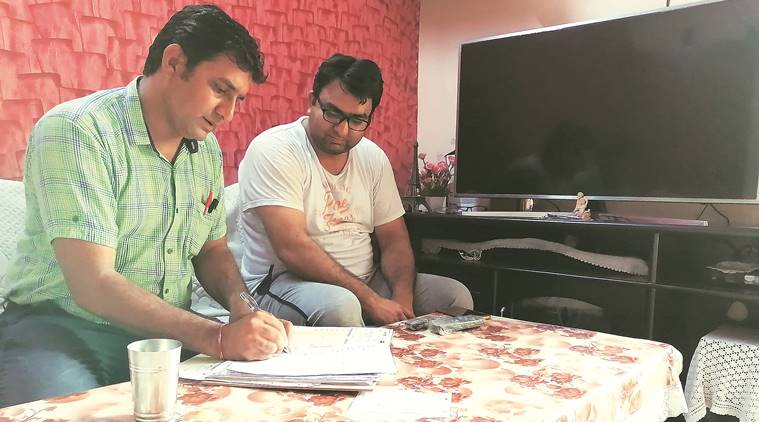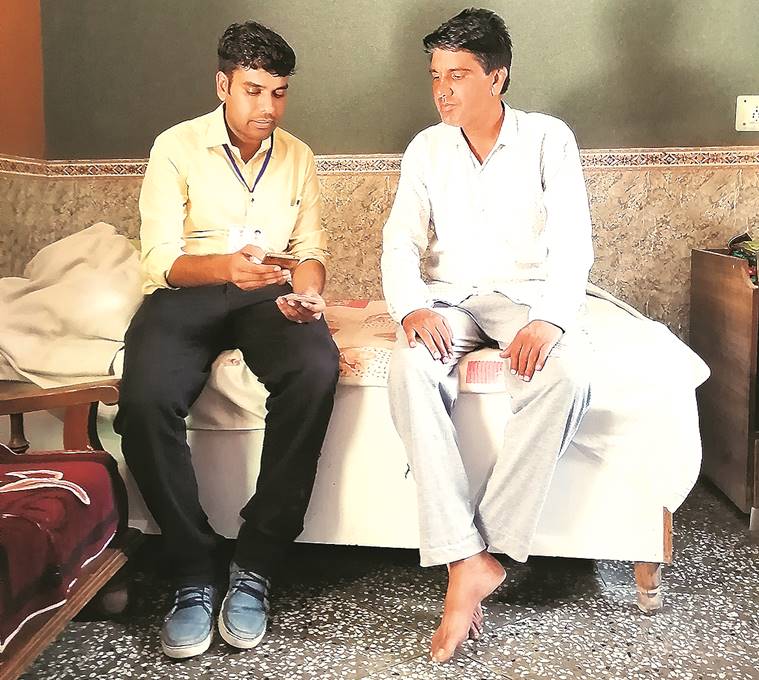
THE latest estimate by the United Nations puts India’s population at 135 crore, catching up to China as the world’s most populous country. In his Independence Day speech, Prime Minister Narendra Modi called the “population explosion” a matter of urgent concern. Against this backdrop, India has begun preparations for what is one of the world’s largest head-count exercises — its decennial Census.
Between February 9 and 28, 2021, India will count all its people. But so as to ensure that there are no hiccups, one-and-a-half years ahead of it, a pre-census began last month. The August 12-September 30 exercise is being conducted at select spots in all the states and Union territories.

One of those enlisted for it is Naveen Shokeen, 31, a Computer Science teacher at Government Boys’ Senior Secondary School (GBSSS) in Ghummanhera, a village on the Delhi-Haryana border. Around 2.30 pm, his school duty having come to an end, Shokeen is standing in the room of Vice-Principal/Headmaster Prem Kumar Jha, the designated “charge-officer” of the pre-test, waiting for instructions. Shokeen hasn’t had lunch, and decides against a quick bite.
Shokeen along with seven teachers of GBSSS, Ghummanhera, and four from a neighbouring public girls’ school, will today collect ‘House Listing (HL)’ data across 10 Census blocks of the Ghummanhera village. The data will include information on types of houses as well as the facilities they have, like LPG connection, dish antenna etc. A Census official says Ghummanhera was an obvious choice as it has “10 blocks as well as slum areas”, as required by the guidelines.
In Delhi, the trial run is also being conducted in all the 67 Census blocks of Vikaspuri, a residential locality in North Delhi, as the guidelines also call for an “urban” block. Here the pre-test is being carried out by teachers of GBSSS, Vikaspuri.
It’s mostly principals who pick the teachers for Census duty, and the latter get a remuneration for the work.
After the briefing by Jha, Shokeen hurries to Ghummanhera, just 200 metres away. As he enters a three-storey house, one of the few such buildings in the area, Shokeen says, “I have finished surveying most of the houses allotted to me. Only those found locked during the survey are left.”
As a resident opens the door, Shokeen flashes his Census identity card. “Janaganana vibhag se aye hain. Aapke makaan ke baarey mein jaankari chahiye (I have come from the Census Department. I want information about your house),” he says.
Shokeen has a list of 34 questions, including on the construction material of the house, and its water and energy sources. He notes the answers down in a voluminous booklet. Most of the questions have remained the same over the decade. The one major change this year is the development of a mobile application that enumerators like Shokeen are expected to use to note the details.
More than 90 per cent of the enumerators for the pre-test have registered for data collection through their own mobile devices.
However, Shokeen says he prefers taking down the answers in the booklet provided by the Census Department, and uploading them later. One of his fears is the leak of personal information of a respondent. However, he admits the duplication slows down the process.
Harjit Singh Mendiratta, a ‘Master Trainer’ with the Directorate of Census Operations, who has been training teachers at GBSSS Ghummanhera, admits the teething problems with the app. “The pre-test helps us get a sense of the difficulties we might face,” he says. “When we plan the Census, we know which blocks could end up taking more time. Secondly, it helps us categorise a property as kachcha, pucca, jhuggi, residential, non-residential, etc.”
After the pre-test on collection of House Listing data gets over on September 4, a trial of the Population Enumeration (PE) basics would be conducted between September 10 and September 30. The PE is a more elaborate exercise as it involves collecting detailed information of each family member.
Detailing the problems they face, Jha says, “Some houses are locked whenever we visit them during the day. As a result, we have to visit early in the morning. Often we have to take the help of neighbours and local leaders as respondents refuse to give information.”
In the evening, even as Shokeen is nearing the end of his rounds, over at Vikaspuri, 36-year-old Srikrishna Sharma, a Sanskrit teacher at GBSSS, is getting ready to begin his. Tired, Sharma says he will keep it short.
“The density of houses as well as people is much higher in urban pockets. So we take more time to cover a specific area,” a perspiring Sharma says, climbing up a flight of stairs in a DDA building in Vikaspuri’s JG block.
Plus Sharma faces the same problems as Shokeen. “Urban households mostly have children at home in the afternoon. If someone is below 18 years, we cannot note their response. But often the adults too behave like children.”
At such times, having ‘Master Trainers’ around, like S K Sood and Pramod Kumar today, helps. Sharma is flanked by both as he rings the bell to a second-floor flat. As the woman who answers looks uncertain about the purpose of his visit, Sood and Kumar, with ‘Ministry of Home Affairs’ identity cards hanging around their necks, weigh in. Sharma wastes no time, and opens the booklet instead of the mobile to take down answers.
Sharma has a different reason for not using the app. “I realised that the moment I took out my phone, people became apprehensive and stopped answering. Somehow, people don’t trust phones… The booklet appears to be much more authentic to them.”
Sharma next moves to the adjacent flat. The woman who answers speaks through a mesh door, and ignoring Sharma’s pleadings, slams the door. Sighs Sharma, “People refuse to answer because of the lack of awareness. The government must educate people on the importance of the Census, pre-test… Many people tell us they have not seen any advertisement or read news reports on the same.”
It takes Sharma about an hour to go through just three flats in the building.
Says a senior Census officer acquainted with the survey, “I have learnt that both the rich and poor don’t want to share personal details. The poor because they don’t care. And the rich because they are concerned their personal information might be stolen.”